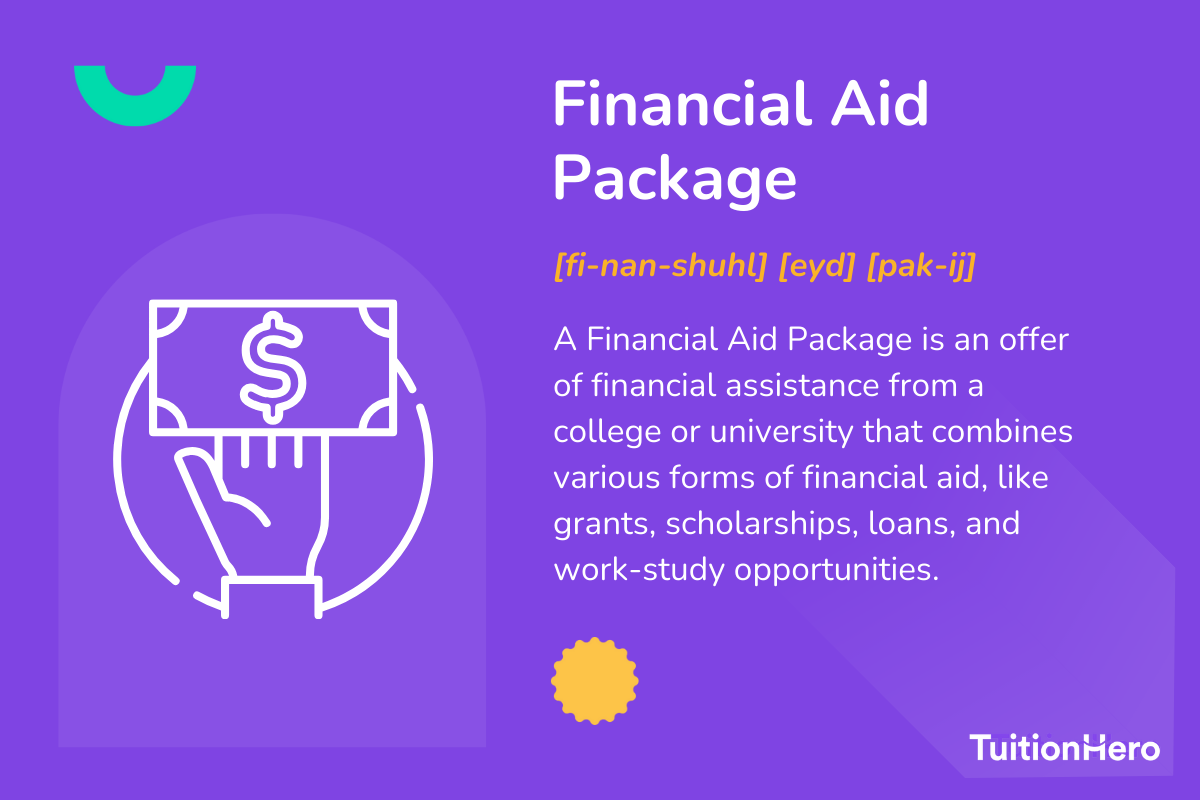Advertiser Disclosure
Last update: November 17, 2024
5 minutes read
What Is a Financial Aid Package?
Wondering what a financial aid package is and its effect on college costs? Learn how to maximize your funding options and reduce debt.

By Derick Rodriguez, Associate Editor
Edited by Brian Flaherty, B.A. Economics
Learn more about our editorial standards



By Derick Rodriguez, Associate Editor
Edited by Brian Flaherty, B.A. Economics
Learn more about our editorial standards
Understanding a financial aid package can be confusing. Many students and parents want to know what it means in terms of paying for college, so it's important to figure this out. Let's explore financial aid, which helps cover costs like tuition and living expenses. We'll talk about student loan options and how they can guide you through the process.

Key takeaways
- Complete the FAFSA early to maximize your financial aid options
- Look for more scholarships and grants beyond initial offers
- Consider work-study and part-time jobs as options to reduce borrowing
What is a financial aid package?
When you fill out the FAFSA for federal aid, you're exploring ways to pay for your education. A financial aid package is a letter that tells you about the different ways you can get money to help with your expenses.
This includes grants, scholarships, work-study opportunities, and both subsidized and unsubsidized federal student loans. Think of it as a customized plan aimed at covering your college expenses, pieced together based on your financial need and the cost of attending your chosen institution.
This package helps you pay for your education by covering the difference between what it costs and what you can pay. It starts with grants and scholarships, which you don't have to pay back. If there's still money needed, it includes work-study opportunities and loans.

Here's what typically gets bundled into these packages:
- Grants and Scholarships: The dream components because they don't need to be repaid.
- Work-Study Programs: These are part-time jobs to help you earn money while in school.
- Federal Student Loans: These need to be repaid, but they come with important protections and lower interest rates than private student loans.
It's important to know that this money helps pay for your education, but it might not cover everything. You might still need more money to pay for your college costs.
To make sure you have enough money, you should look into other financing options, like private student loans. Pay attention to the details of each type of help you get, not just how much money you're offered.
Remember, the details can make a big difference in your college finance plan. For instance, two private loans might have the same interest rate, but that doesn’t mean they’re equivalent options. One loan might come with more flexible repayment plans or deferment options, for example.

TuitionHero Tip
Pay attention to the small things about each type of financial aid you get, and remember important dates and deadlines to get the most out of what you have.
Understanding key components of your financial aid package
Grants and scholarships
Grants and scholarships are like valuable gifts in a financial aid package because you don't have to pay them back. Grants are usually given based on financial need, while scholarships can be based on need or merit. To learn more about your grant options, take a closer look at the Federal Pell Grant, an important federal grant for undergraduates with high financial need.
Work-study jobs
Work-study positions offer a practical way to earn money while pursuing your degree. These roles aren’t just about making money; they're about gaining valuable work experience too. Exploring the Federal Work-Study Program will clarify how students can qualify and what types of jobs might be available, both on and off-campus.
Understanding loans
Loans, whether federal or private, need careful consideration due to the repayment obligation. Federal loans offer many benefits, including fixed interest rates and repayment plan flexibility. It’s worth learning the differences between Direct Loans and Direct Unsubsidized Loans to make informed decisions about borrowing for college.
Compare private student loans now
TuitionHero simplifies your student loan decision, with multiple top loans side-by-side.
Compare Rates
More funding options
Private student loans
If your financial aid package falls short, private student loans can fill the gap. However, they usually come with higher interest rates and less favorable terms than federal loans. For that reason, staying on top of loan payments can be even more important for private loans. Understanding the benefits of electronic funds transfers can be a small but meaningful way to manage loan repayments more effectively.
Scholarship search
Beyond the initial package, ongoing scholarship searches can help you find new funding opportunities. Each scholarship has its own set of criteria and deadlines, making early and diligent searching a key strategy. See how exploring scholarship options can supplement your financial aid package.
Dos and don'ts of managing your financial aid package
Understanding your financial aid package is important for getting the most help with college costs. Knowing what to do and what not to do is key to making smart choices about how you pay for college. Here's a concise data table that outlines the key actions to take and the mistakes to avoid:
Do
Do complete the FAFSA as early as possible.
Do review your financial aid package thoroughly.
Do explore scholarship opportunities beyond the initial package.
Do consider work-study as a way to reduce borrowing.
Do assess the need for a private student loan carefully.
Don't
Don't miss deadlines for applications or document submissions.
Don't overlook the terms and conditions of loans.
Don't assume all grants and scholarships are renewable without conditions.
Don't ignore the possibility of part-time employment if work-study isn't offered.
Don't rush into borrowing without comparing loan terms.

Advantages and disadvantages of borrowing for college
Understanding the implications of borrowing for college is key to making effective financial decisions. Borrowing can be a gateway to education for many, but it's important to weigh the pros and cons before committing to loans.
- Loans can cover gaps in funding, allowing students to attend their chosen colleges.
- Federal loans come with lower interest rates, providing manageable repayment.
- Repayment plans, including income-driven options, offer flexibility for federal loans.
- Borrowing can build credit when managed responsibly.
- Interest accrues over time, increasing the total amount owed.
- Borrowing too much can lead to long-term financial strain.
- Private loans usually have higher interest rates and fewer repayment options compared to federal loans.
- Defaulting on student loans can severely affect credit scores and future borrowing ability.

Why trust TuitionHero
At TuitionHero, we help make college finance easier for you. We connect you to lenders for student loans, guide you on scholarships, and simplify the FAFSA process. Our blog offers insights, and our tools help make sure you make informed decisions about your financial aid. Our goal is to make paying for education easy and straightforward, paving the way for a brighter academic future.
Frequently asked questions (FAQ)
If your financial situation changes or if you think your college's first offer could be better, you can ask them to take another look at your financial aid. They might change it if you give them more information or if your family's financial situation changes. It's a good idea to be careful and explain your situation clearly, and show any papers that support what you're saying.
Start by using TuitionHero's scholarship search tool to filter opportunities by your interests, field of study, and unique qualifications. Plus, check with your high school's guidance office and your intended college's financial aid office for listings. Engaging in community organizations and related professional associations in your field of interest can also uncover niche scholarship opportunities tailored to your background and career goals.
If you're not eligible for federal work-study or if it's not included in your financial aid package, consider getting a part-time job on or near your campus. Many colleges offer job boards with listings for students; these can include roles in university departments, local businesses, or nonprofits. Securing a part-time job can not only supplement your income but also strengthen your resume with valuable work experience.
Final thoughts
Understanding your financial aid package is crucial for managing college expenses. TuitionHero is here to guide you with resources and support. Your financial aid package is just a starting point, so make sure to explore and ask questions. Let TuitionHero help you navigate the financial aspects of your college education with confidence so you can make smart financial decisions.
Source
Author

Derick Rodriguez
Derick Rodriguez is a seasoned editor and digital marketing strategist specializing in demystifying college finance. With over half a decade of experience in the digital realm, Derick has honed a unique skill set that bridges the gap between complex financial concepts and accessible, user-friendly communication. His approach is deeply rooted in leveraging personal experiences and insights to illuminate the nuances of college finance, making it more approachable for students and families.
Editor

Brian Flaherty
Brian is a graduate of the University of Virginia where he earned a B.A. in Economics. After graduation, Brian spent four years working at a wealth management firm advising high-net-worth investors and institutions. During his time there, he passed the rigorous Series 65 exam and rose to a high-level strategy position.
At TuitionHero, we're not just passionate about our work - we take immense pride in it. Our dedicated team of writers diligently follows strict editorial standards, ensuring that every piece of content we publish is accurate, current, and highly valuable. We don't just strive for quality; we aim for excellence.
Related posts
While you're at it, here are some other college finance-related blog posts you might be interested in.
Shop and compare student financing options - 100% free!

Always free, always fast
TuitionHero is 100% free to use. Here, you can instantly view and compare multiple top lenders side-by-side.

Won’t affect credit score
Don’t worry – checking your rates with TuitionHero never impacts your credit score!

Safe and secure
We take your information's security seriously. We apply industry best practices to ensure your data is safe.
Finished scrolling? Start saving & find your private student loan rate today





